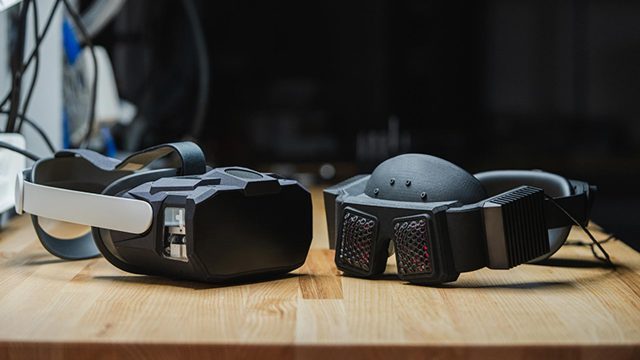Meta unveiled two new VR headset prototypes that showcase more progress in the fight to solve some persistent technical challenges facing VR today. Presenting at SIGGRAPH 2023, Meta is demonstrating a headset with retinal resolution combined with varifocal optics, and another headset with advanced light field passthrough capabilities.
Butterscotch Varifocal Prototype
Revealed in a developer blogpost, Meta showed off a varifocal research prototype that demonstrates a VR display system which provides “visual clarity that can closely match the capabilities of the human eye,” says Meta Optical Scientist Yang Zhao. The so-called ‘Butterscotch Varifocal’ prototype provides retinal resolution of up to 56 pixels per degree (PPD), which is sufficient for 20/20 visual acuity, researchers say.
Since its displays are also varifocal, it can support from 0 to 4 diopter (i.e. infinity to 25 cm), and matching what researchers say are “the dynamics of eye accommodation with at least 10 diopter/s peak velocity and 100 diopter/s2 acceleration.” The pulsing motors below control the displays’ focal distance in an effort to match the human eye.
Varifocal headsets represent a solution to the vergence-accommodation conflict (VAC) which has plagued standard VR headsets, the most advanced consumer headsets included. Varifocal headsets not only include the same standard support for the vergence reflex (when eyes converge on objects to form a stereo image), but also the accommodation reflex (when the lens of the eye changes shape to focus light at different depths). Without support for accommodation, VR displays can cause eye strain, make it difficult to focus on close imagery, and may even limit visual immersion.
Check out the through-the-lens video below to see how Butterscotch’s varifocal bit works:
Using LCD panels readily available on the market, Butterscotch manages its 20/20 retinal display by reducing the field of view (FOV) to 50 degrees, smaller than Quest 2’s ~89 degree FOV.
Although Butterscotch’s varifocal abilities are similar to the company’s prior Half Dome prototypes, the company says Butterscotch is “solely focused on showcasing the experience of retinal resolution in VR—but not necessarily with hardware technologies that are ultimately appropriate for the consumer.”
“In contrast, our work on Half Dome 1 through 3 focused on miniaturizing varifocal in a fully practical manner, albeit with lower-resolution optics and displays more similar to today’s consumer headsets,” explains Display Systems Research Director Douglas Lanman. “Our work on Half Dome prototypes continues, but we’re pausing to exhibit Butterscotch Varifocal to show why we remain so committed to varifocal and delivering better visual acuity and comfort in VR headsets. We want our community to experience varifocal for themselves and join in pushing this technology forward.”
Flamera Lightfield Passthrough Prototype
Another important side of making XR more immersive is undoubtably the headset’s passthrough capabilities, like you might see on Quest Pro or the upcoming Apple Vision Pro. The decidedly bug-eyed design of Meta’s Flamera research prototype is looking for a better way to create more realistic passthrough by using light fields.
In standard headsets, cameras are typically placed a few inches from where your eyes actually sit, capturing a different view than what you’d see if you weren’t wearing a headset. While there’s a lot of distortion and placement correction going on in standard headsets of today, you’ll probably still notice a ton of visual artifacts as the software tries to correctly resolve and render different depths of field.
“To address this challenge, we brainstormed optical architectures that could directly capture the same rays of light that you’d see with your bare eyes,” says Meta Research Scientist Grace Kuo. “By starting our headset design from scratch instead of modifying an existing design, we ended up with a camera that looks quite unique but can enable better passthrough image quality and lower latency.”
Check out the quick explainer below to see how Flamera’s ingenious capture methods work:
Now, here’s a comparison between an unobstructed view and Flamera’s light field capture, showing off some pretty compelling results:
As research prototypes, there’s no indication when we can expect these technologies to come to consumer headsets. Still, it’s clear that Meta is adamant about showing off just how far ahead it is in tackling some of the persistent issues in headsets today—something you probably won’t see from the patently black box that is Apple.
You can read more about Butterscotch and Flamera in their respective research papers, which are being presented at SIGGRAPH 2023, taking place August 6th – 10th in Los Angeles. Click here for the Butterscotch Varifocal abstract and Flamera full paper.






